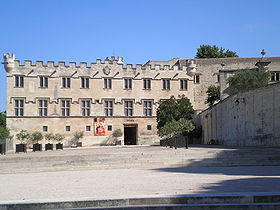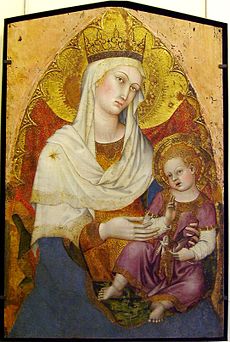- Musée du Petit Palais, Avignon
-
The Musée du Petit Palais is a museum and art gallery in Avignon, southern France. It opened in 1976 and has an exceptional collection of Renaissance paintings of the Avignon school as well as from Italy, which reunites many "primitives" from the collection of Giampietro Campana. It is housed in a 14th century building at the north side of the square overlooked by the Palais des Papes.
Building
Named Petit Palais to distinguish it from the Palais des Papes, it was built before the Western Schism by Cardinal Bérenger Fredoli the Elder c.1318-20, with four wings around a cloister and a service court. The palace and a few neighbouring buildings were bought on de Frédol's death in 1323 by Cardinal Arnaud de Via, nephew of the reigning Pope. However, de Via then died in 1335 and the building remained vacant until Pope Benedict XII bought it for use as the bishopric.
The building suffered was attacked and bombarded during its use from 1396 to 1411 as a fortified citadel during the Western Schism, and was a wreck by the time the war ended. In the second half of the 15th century, Bishop Alain de Coëtivy and his successor, Giuliano della Rovere (the future Pope Julius II) carried out restoration work, giving the Palace more or less its present appearance by 1503. Della Rovere arrived in Avignon in 1474, having been made bishop of Avignon and papal legate of Avignon by his uncle Pope Sixtus IV. He added new south and west facades in Italian Renaissance style (with oculi, a west-facing door surmonted with a triangular pediment, window drip-moldings and his insignia facing south) and, in 1487, a tower (which collapsed in 1767). The Palace became known as the Palace of the Archbishop when the city was promoted to an archbishopric soon after della Rovere took office.
During the French Revolution, the palace was nationalised and sold off, becoming a Catholic secondary school in the 19th century and (from 1904 to 1976) a professional and technical school.
Collection
- Many works by italian and french primitive or early-renaissance painters such as Sandro Botticelli (Madonna with Child, c. 1467), Vittore Carpaccio, Carlo Crivelli, Benozzo Gozzoli, Raffaellino del Garbo, Lorenzo Monaco, Jacopo del Sellaio, Francesco Botticini, Enguerrand Quarton or Josse Lieferinxe.
- The effigy head from the tomb of Antipope Clement VII; the rest of the tomb was destroyed during the French Revolution.
External links
Coordinates: 43°57′9.5″N 4°48′23″E / 43.952639°N 4.80639°E
Categories:- Art museums and galleries in France
- Avignon
- 14th-century architecture
- 15th-century architecture
- Medieval French architecture
Wikimedia Foundation. 2010.


